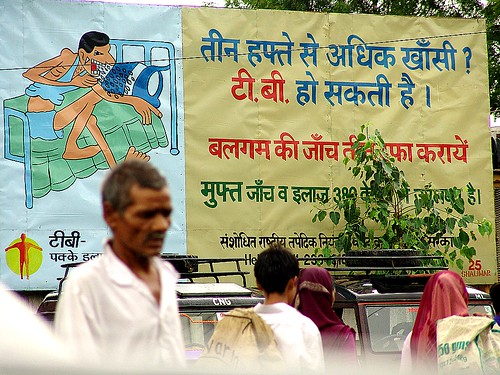
I recommend that before you read this entry, you go here. Right click, open it in an another window. Then come back here, and read.
Tuberculosis (TB) is mostly an illness of the poor. It is caused by a bacterium called Mycobacterium tuberculosis. It’s hard to get tuberculosis if you have a fully functioning immune system and a nutritious diet. It’s easy to get tuberculosis if you are sick, hungry, or have HIV. People who have HIV in developing countries are very likely to also get TB. There are three kinds of tuberculosis. All are equally infectious, but some are much more fatal once you are infected.
1. Regular, which can be cured with a standard regimen of drugs, most often the regimen recommended by the “directly observed therapy short-course”, or DOTS. If your get proper treatment, it is pretty easy to survive regular tuberculosis. (And training doctors to use the DOTS drugs will ensure that the largest percentage of TB patients get better.) People in the developing world are often afraid to go for treatment, but tuberculosis can be cured, and treatment is free in many countries.
2. Multi-Drug Resistant Tuberculosis (MDR TB). This is a TB infection that cannot be cured with the usual drugs. Doctors must prescribe second-line drugs to cure this form of TB. There are two ways to get MDR TB. You can get regular TB, and be prescribed the wrong combination of drugs, or fail to take your drugs. This will mean that the weak bacteria in your body are killed by antibiotics, leaving the stronger ones to breed and take over. These survivor bacteria cannot be killed by the usual drugs. You may also get tuberculosis from someone who has gone through this process and has MDR TB; your bacteria will therefore be the stronger, survivor bacteria even at the beginning of the infection.
CDC MDR TB fact sheet
Wikipedia entry on MDR TB
3. Extremely Drug-Resistant Tuberculosis. (XDR TB) This is the worst kind of TB to be infected with. It cannot be treated with the normal, first-line drugs, or the less common drugs used for MDR TB. It requires rare, third-line drugs to cure it. These drugs are more expensive, harder to store, and may have severe side effects. 50-80% of XDR TB can be treated or cured.
Medical News Today on XDR TB
The WHO on XDR TB
The Stop TB alliance on XDR TB
For a long time, drug companies didn’t bother to research and develop new antibiotics. They were cheap and didn’t make a huge profit margin, and so effective that new ones were not really necessary. When drug-resistant TB first showed up, there were no second and third-line drugs. Doctors used veterinary drugs never used for people, and old-fashioned antibiotics that had been discontinued because of dangerous side-effects.
We can stop TB by improving the availability of good TB drugs, reducing the incidence of HIV/AIDS, or making poverty less common. Your money is well spent on any of those things.
This entry was inspired by James Nachtwey, and his TED Prize wish.

Thanks for posting this – In the United States and other ‘developed’ nations TB is something many children, and adults for that matter, haven’t even heard of. It is, in fact, a disease of the poor – and those in poverty can take simple steps to avoid the disease altogether they just aren’t educated enough. Coincidentally I just wrote a post on ‘diarrhea’ another greatly misunderstood disease.
Diarrhea is a huge killer in the developing world; I agree Americans have no idea what it can do.
A very useful entry – thanks a lot!
Helping countries like China to fix their dysfunctional health systems (where doctors routinely prescribe antibiotics for just about anything) would probably take us a long way towards stopping TB.
The Guardian: Ailing system leaves sick to pay up or die (14 Sep 2007).
I’m glad you liked the entry. And I second your opinion – I think we should always take a systems approach to health issues.